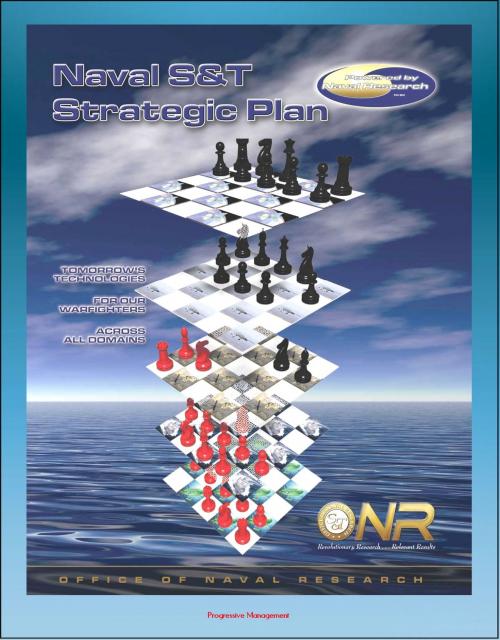Office of Naval Research Naval Science & Technology (S&T) Strategic Plan: Tomorrow's Technologies for Our Warfighters Across All Domains - Military Research, Unmanned Systems, Expeditionary Warfare
Nonfiction, Science & Nature, Technology, Military Science, History, Military, Naval| Author: | Progressive Management | ISBN: | 9781476440026 |
| Publisher: | Progressive Management | Publication: | July 24, 2012 |
| Imprint: | Smashwords Edition | Language: | English |
| Author: | Progressive Management |
| ISBN: | 9781476440026 |
| Publisher: | Progressive Management |
| Publication: | July 24, 2012 |
| Imprint: | Smashwords Edition |
| Language: | English |
This is the third iteration of the Naval Science & Technology Strategic Plan, and it reflects the evolution of future requirements combined with the fiscal realities of today. We have tightened the number of S&T Focus Areas, adjusted our investment strategy and streamlined processes to leverage innovations that can meet emerging requirements and quickly transition new technologies. Developed in collaboration with stakeholders and approved by the S&T Corporate Board, this plan has three principal goals: (1) align Naval S&T with Naval mission and future capability needs; (2) balance and manage the S&T portfolio; and (3) communicate the S&T vision and approach to senior decision-makers, key stakeholders, partners, customers, and performers. In approving this plan, the S&T Corporate Board emphasized the need for increased senior Navy and Marine Corps leadership engagement in the S&T process with the goal of providing greater clarity on the Fleet and Force demand signals and focusing future capability investments, critical in the anticipated fiscal environment.
The Naval Science and Technology (S&T) Strategic Plan describes how the Office of Naval Research (ONR) sponsors scientific research efforts that will enable the future operational concepts of the Navy and the Marine Corps. Department of Defense (DoD) and Department of the Navy (DON) strategic documents provide the basic foundation for this plan. The priorities of the Secretary of the Navy (SECNAV), Chief of Naval Operations (CNO) and Commandant of the Marine Corps (CMC) are reflected in the shape of the investment portfolio and nine S&T Focus Areas outlined in the plan. This is a broad strategy that articulates a general direction for the future, while retaining sufficient flexibility and freedom of action to meet emerging challenges or alter course as directed by senior Naval leadership. The Navy and Marine Corps depend on S&T to discover, develop and demonstrate high-payoff, game-changing technologies to ensure the Fleet/Force retain a significant advantage over potential adversaries. This plan enables tomorrow's technologies for our warfighters across all domains.
Foreword * Science & Technology Corporate Board Decision Memorandum * Chapter 1 * Introduction * Chapter 2 * Background * Management Approach * S&T Outputs * S&T Enablers * Chapter 3 * Strategy Development * Hedging Against Uncertainty * Strategy Process * Strategy Timeframe * S&T Taxonomies * Chapter 4 * Naval S&T Focus Areas * Assure Access to the Maritime Battlespace * Autonomy and Unmanned Systems * Expeditionary and Irregular Warfare * Information Dominance * Platform Design and Survivability * Power and Energy * Power Projection and Integrated Defense * Total Ownership Cost * Warfighter Performance * Chapter 5 * Implementation * Discovery and Invention * Leap Ahead Innovations * Acquisition Enablers * Quick Reaction and Other S&T * Speed to Fleet * Naval Research Laboratory * Global Technology Awareness * ONR Global * Naval Research Enterprise * National Naval Responsibilities * Science and Engineering Workforce * Science, Technology, Engineering and Mathematics * Development and Sustainment * Interagency Coordination and Alliance * Measuring Success * Business Processes * Chapter 6 * Execution * Chapter 7 * Summary
This is the third iteration of the Naval Science & Technology Strategic Plan, and it reflects the evolution of future requirements combined with the fiscal realities of today. We have tightened the number of S&T Focus Areas, adjusted our investment strategy and streamlined processes to leverage innovations that can meet emerging requirements and quickly transition new technologies. Developed in collaboration with stakeholders and approved by the S&T Corporate Board, this plan has three principal goals: (1) align Naval S&T with Naval mission and future capability needs; (2) balance and manage the S&T portfolio; and (3) communicate the S&T vision and approach to senior decision-makers, key stakeholders, partners, customers, and performers. In approving this plan, the S&T Corporate Board emphasized the need for increased senior Navy and Marine Corps leadership engagement in the S&T process with the goal of providing greater clarity on the Fleet and Force demand signals and focusing future capability investments, critical in the anticipated fiscal environment.
The Naval Science and Technology (S&T) Strategic Plan describes how the Office of Naval Research (ONR) sponsors scientific research efforts that will enable the future operational concepts of the Navy and the Marine Corps. Department of Defense (DoD) and Department of the Navy (DON) strategic documents provide the basic foundation for this plan. The priorities of the Secretary of the Navy (SECNAV), Chief of Naval Operations (CNO) and Commandant of the Marine Corps (CMC) are reflected in the shape of the investment portfolio and nine S&T Focus Areas outlined in the plan. This is a broad strategy that articulates a general direction for the future, while retaining sufficient flexibility and freedom of action to meet emerging challenges or alter course as directed by senior Naval leadership. The Navy and Marine Corps depend on S&T to discover, develop and demonstrate high-payoff, game-changing technologies to ensure the Fleet/Force retain a significant advantage over potential adversaries. This plan enables tomorrow's technologies for our warfighters across all domains.
Foreword * Science & Technology Corporate Board Decision Memorandum * Chapter 1 * Introduction * Chapter 2 * Background * Management Approach * S&T Outputs * S&T Enablers * Chapter 3 * Strategy Development * Hedging Against Uncertainty * Strategy Process * Strategy Timeframe * S&T Taxonomies * Chapter 4 * Naval S&T Focus Areas * Assure Access to the Maritime Battlespace * Autonomy and Unmanned Systems * Expeditionary and Irregular Warfare * Information Dominance * Platform Design and Survivability * Power and Energy * Power Projection and Integrated Defense * Total Ownership Cost * Warfighter Performance * Chapter 5 * Implementation * Discovery and Invention * Leap Ahead Innovations * Acquisition Enablers * Quick Reaction and Other S&T * Speed to Fleet * Naval Research Laboratory * Global Technology Awareness * ONR Global * Naval Research Enterprise * National Naval Responsibilities * Science and Engineering Workforce * Science, Technology, Engineering and Mathematics * Development and Sustainment * Interagency Coordination and Alliance * Measuring Success * Business Processes * Chapter 6 * Execution * Chapter 7 * Summary















